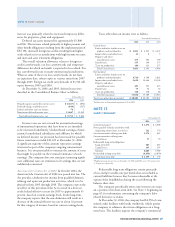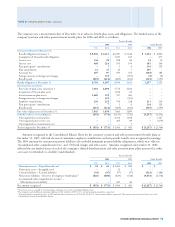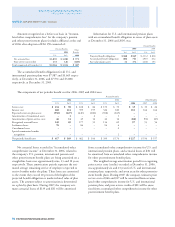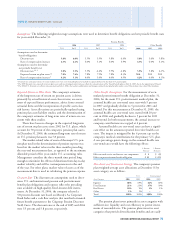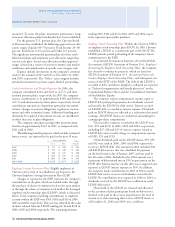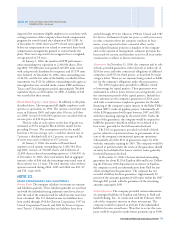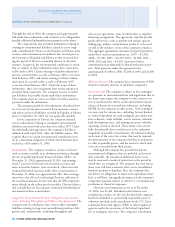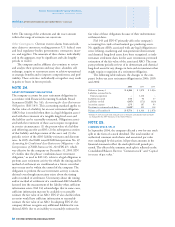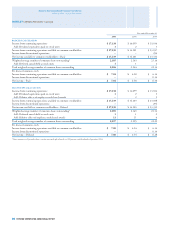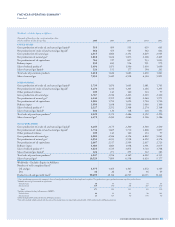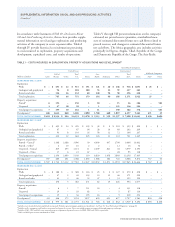Chevron 2006 Annual Report Download - page 79
Download and view the complete annual report
Please find page 79 of the 2006 Chevron annual report below. You can navigate through the pages in the report by either clicking on the pages listed below, or by using the keyword search tool below to find specific information within the annual report.
CHEVRON CORPORATION 2006 ANNUAL REPORT 77CHEVRON CORPORATION 2006 ANNUAL REPORT 77
Thousands 2006 2005
Allocated shares 21,827 23,928
Unallocated shares 8,316 9,163
Total LESOP shares 30,143 33,091
Benefi t Plan Trusts Texaco established a benefi t plan trust
for funding obligations under some of its benefi t plans. At
year-end 2006, the trust contained 14.2 million shares of
Chevron treasury stock. The company intends to continue to
pay its obligations under the benefi t plans. The trust will sell
the shares or use the dividends from the shares to pay ben-
efi ts only to the extent that the company does not pay such
benefi ts. The trustee will vote the shares held in the trust as
instructed by the trust’s benefi ciaries. The shares held in the
trust are not considered outstanding for earnings-per-share
purposes until distributed or sold by the trust in payment of
benefi t obligations.
Unocal established various grantor trusts to fund obliga-
tions under some of its benefi t plans, including the deferred
compensation and supplemental retirement plans. At December
31, 2006 and 2005, trust assets of $98 and $130, respectively,
were invested primarily in interest-earning accounts.
Management Incentive Plans Chevron has two incentive
plans, the Management Incentive Plan (MIP) and the Long-
Term Incentive Plan (LTIP), for officers and other regular
salaried employees of the company and its subsidiaries who
hold positions of signifi cant responsibility. The MIP is an
annual cash incentive plan that links awards to performance
results of the prior year. The cash awards may be deferred by
the recipients by conversion to stock units or other invest-
ment fund alternatives. Aggregate charges to expense for
MIP were $180, $155 and $147 in 2006, 2005 and 2004,
respectively. Awards under the LTIP consist of stock options
and other share-based compensation that are described in
Note 22 below.
Other Incentive Plans The company has a program that
provides eligible employees, other than those covered by
MIP and LTIP, with an annual cash bonus if the company
achieves certain fi nancial and safety goals. Charges for the
programs were $329, $324 and $339 in 2006, 2005 and
2004, respectively.
NOTE 22.
STOCK OPTIONS AND OTHER SHARE-BASED COMPENSATION
Effective July 1, 2005, the company adopted the provisions of
Financial Accounting Standards Board (FASB) Statement No.
123R, Share-Based Payment (FAS 123R), for its share-based
compensation plans. The company previously accounted for
these plans under the recognition and measurement principles
of Accounting Principles Board Opinion No. 25, Accounting for
Stock Issued to Employees, and related interpretations and dis-
closure requirements established by FASB Statement No. 123,
Accounting for Stock-Based Compensation (FAS 123).
The company adopted FAS 123R using the modifi ed pro-
spective method and, accordingly, results for prior periods were
not restated. Refer to Note 1, beginning on page 56, for the
pro forma effect on net income and earnings per share as if the
company had applied the fair-value recognition provisions of
FAS 123 for periods prior to adoption of FAS 123R.
For 2006 and 2005, compensation expense charged
against income for stock options was $125 ($81 after tax)
and $65 ($42 after tax), respectively. In addition, compensa-
tion expense charged against income for stock appreciation
rights, performance units and restricted stock units was $113
($73 after tax), $59 ($39 after tax) and $65 ($42 after tax)
for 2006, 2005 and 2004, respectively. There were no signifi -
cant stock-based compensation costs at December 31, 2006
and 2005, that were capitalized.
Cash received from option exercises under all share-
based payment arrangements for 2006, 2005 and 2004 was
$444, $297 and $385, respectively. Actual tax benefi ts real-
ized for the tax deductions from option exercises were $91,
$71 and $49 for 2006, 2005 and 2004, respectively.
Cash paid to settle performance units and stock apprecia-
tion rights was $68, $110 and $23 for 2006, 2005 and 2004,
respectively. Cash paid in 2005 included $73 for Unocal awards
paid under change-in-control plan provisions.
The company presents the tax benefi ts of deductions from
the exercise of stock options as fi nancing cash infl ows in the
Consolidated Statement of Cash Flows. In the second quarter
2006, the company implemented the transition method of
FASB Staff Position FAS 123R-3, Transition Election Related to
Accounting for the Tax Effects of Share-Based Payment Awards,
for calculating the beginning balance of the pool of excess tax
benefi ts related to employee compensation and determining the
subsequent impact on the pool of employee awards that were
fully vested and outstanding upon the adoption of FAS 123R.
The company’s reported tax expense for the period subsequent
to the implementation of FAS 123R was not affected by this
election. Refer to Note 3, beginning on page 59, for informa-
tion on excess tax benefi ts reported on the company’s Statement
of Cash Flows.
In the discussion below, the references to share price
and number of shares have been adjusted for the two-for-one
stock split in September 2004.
Chevron Long-Term Incentive Plan (LTIP) Awards under the
LTIP may take the form of, but are not limited to, stock
options, restricted stock, restricted stock units, stock appre-
ciation rights, performance units and non-stock grants. From
April 2004 through January 2014, no more than 160 mil-
lion shares may be issued under the LTIP, and no more than
NOTE 21. EMPLOYEE BENEFIT PLANS – Continued




